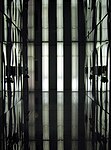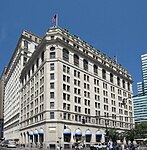Whitehall Building

The Whitehall Building is a three-section residential and office building near the southern tip of Manhattan Island in New York City, adjacent to Battery Park in lower Manhattan. The original 20-story structure on Battery Place, between West Street and Washington Street, was designed by Henry Janeway Hardenbergh, while the 31-story Whitehall Building Annex on West Street was designed by Clinton and Russell. The original building and annex are both at 17 Battery Place. Another 22-story addition at 2 Washington Street, an International Style building located north of the original building and east of the annex, was designed by Morris Lapidus. The original Whitehall Building and its annex has a Renaissance Revival style facade, and the two original structures' articulations consist of three horizontal sections similar to the components of a column—namely a base, shaft, and capital. Since the building is located on landfill along the Hudson River, its foundation incorporates a non-standard design. The Whitehall Building is named after the nearby estate of New Amsterdam colonial governor Peter Stuyvesant. The original building was built as a speculative development in 1902–1904 for Robert A. and William H. Chesebrough, a real estate company. The annex was built in 1908–1910, and 2 Washington Street was built in 1972. In 2000, the New York City Landmarks Preservation Commission (LPC) designated the Whitehall Building as an official city landmark. The upper floors of the original building and annex were converted to apartments, while the lower floors remain in use as an office building.
Excerpt from the Wikipedia article Whitehall Building (License: CC BY-SA 3.0, Authors, Images).Whitehall Building
Battery Park Underpass, New York Manhattan
Geographical coordinates (GPS) Address Nearby Places Show on map
Geographical coordinates (GPS)
| Latitude | Longitude |
|---|---|
| N 40.705555555556 ° | E -74.016111111111 ° |
Address
Whitehall Building Annex
Battery Park Underpass
10280 New York, Manhattan
New York, United States
Open on Google Maps








